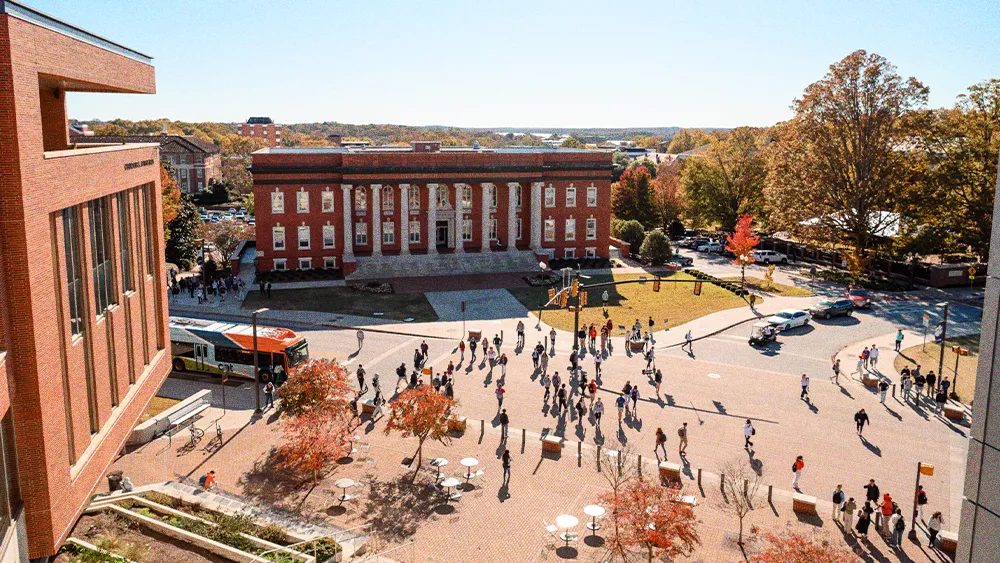
Key Points
- Most higher education institutions are struggling with the significant financial and technological pressures of long-neglected digital infrastructure.
- Brian Voss, VP and CIO at Clemson University, explained how institutions often hire tech leaders to be strategists but then put them into "plumber" roles to fix fundamental issues.
- To fix the "plumbing" and avoid disruption, leaders can use secure, licensed AI tools that protect university data.
External pressures are testing the higher education sector across finance, demographics, and technology. For many institutions, decades of deferred maintenance on their digital infrastructure have created operational and strategic challenges. Now, long-standing issues with technology investment and management are emerging as a result.
To make sense of this complexity, we spoke with Brian D. Voss, Vice President and CIO for Clemson University. With over 40 years of experience in higher education information technology, Voss has held leadership roles at the University of Maryland and Louisiana State University. As an independent consultant and EDUCAUSE's first-ever Presidential Fellow, Voss has developed a uniquely broad view of the challenges now facing the sector. From his perspective, a primary challenge to adaptation in higher education is a fundamental misunderstanding of the CIO's role—an "age-old debate" he boiled down to a conflict between the "strategist" and the "plumber."
"When universities go to hire a CIO, they write a flowery job description talking about transformation and finding a visionary leader. Then they plop that person down into a facility where all the pipes are leaking. The sewer is backing up, and they tell them they have to fix all of that before they can be the strategist they were hired to be," Voss said. The problem stems from two institutional mindsets that have often characterized university IT for decades, he explained.
Subservience and scarcity: "IT has always faced two common problems of culture. One is a culture of frugality, meaning you just don't get enough money to do the job. The other is a culture of subservience. Here, you're seen as the tech people who must do whatever is asked without questioning, so long as it's the right thing for the institution," he said.
The high cost of a mismatch: Often, this kind of hiring mismatch leads to failure, Voss continued. "What institutions don't realize is they're creating all these little pockets, and they're spending more money than if they had put the right thing into a centralized environment and structured it correctly."
Next, Voss framed the massive external pressures on top of this crumbling foundation as "two cat-five hurricanes and an alien invasion." The first hurricane is a budget crisis, driven by an "enrollment cliff." The second is a storm in federal research funding, with agencies facing cuts that threaten jobs across academic science. Meanwhile, the "alien invasion" is AI, a cross-industry challenge that is a far more aggressive disruptor with a "90-day" assimilation cycle, Voss said. However, the fact that these problems persist highlights a more significant inability for the sector to adapt, he admitted.
Yesterday's playbook: But it also explains why Voss often looks to proven, historical playbooks for his solutions. "What I found interesting is that the things I wrote for EDUCAUSE 12 or 15 years ago are still applicable today. What that tells me is that despite all the lessons learned and all the advances, we're still fighting problems from 15 or 20 years ago. That's the plumbing."

Ultimately, Voss’s diagnosis served as the foundation for his pragmatic plan to address the AI "invasion." The first step is to tame the "Wild West" of consumer-grade AI tools by applying a proven playbook from past tech disruptions called the "IT Abundance" model, he explained.
Taming the wild west: The business case for this approach is protecting the university's "sovereign information," Voss said. "One of the reasons that's important is, if you have a site license, these vendors will allow you to keep your information in your own instance so that your data, your sovereign information, isn't being used to train the broader model. You don't get that without a site license. We've got people on campus today using ChatGPT, and they're putting all sorts of stuff in there, and OpenAI is using it, just because it's out there."
Choosing your dance partner: Next, Voss described the field of AI vendors as one requiring careful navigation. "You've got these main ones that privately held companies own, and an unfriendly nation-state produces the other. So, yeah, who are you going to ask to the dance? Then you have frontier AIs. So, no, no, no. We stay away from that."
To make the point clear, Voss made the calculator analogy. Like calculators, AI should be viewed as an instrument capable of pushing students toward deeper problem-solving, not as a tool for cheating, he said. "If our graduates next May don't have any AI exposure, when they go to interview for jobs, that's a question: 'What do you know about AI?' 'Nothing?' 'Okay, next.'" However, research already suggests that 90% of students already use AI.
Meanwhile, faculty buy-in remains a key focus area for Voss: "Faculty would construct a test based on how long it would take you to use the slide rule. I'd walk in with my HP 100, equipped with reverse Polish notation, and get that done in 20 minutes. So what did the faculty do to adapt? They added more questions and more difficult questions. The tool allowed me to learn more about solving problems as opposed to learning how to finagle all this crap. And I think AI has that same potential."
Ultimately, Voss's message to higher education leaders is straightforward: you cannot be a strategist until the plumbing gets fixed. "I'm a plumber. I have a degree in industrial engineering, so I fix problems. But my good friend Brad Wheeler, who's a former CIO at Indiana University with a PhD in business, thinks big thoughts. He was also at the Taj Mahal of IT, Indiana University. Because it had already fixed its tech debt problem, he was riding a platform where he could think big thoughts. I have often been in places that aren't like that—places with a lot of plumbing. If your institution has extensive plumbing needs, consider hiring a professional plumber. If you hire a strategist, you won't get the plumbing fixed."
.svg)





